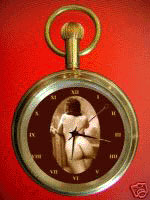Invented and enacted by Allan Douglass Coleman, witnessed by many, remembered by few, The Derrière Garde's unprecedented action lingers in some dusty records and the brain cells of such observers as Douglas Sheer, Lori Antonacci, William Messer, Tricia Grantz, and Edward Coleman. Conceivably, despite his best efforts, some fragmentary description of his behavior that day somehow survives on still or movie film, videotape, or audiotape.
| Then as now, the Derrière Garde operated on the theory that every avant garde needs a derrière garde -- someone to help cover its ass, so to speak,1 since, as Newton's Third Law tells us, "for every action, there is an equal and opposite reaction." However, he seems to have found the condition of the avant garde in '75 so distressingly housebroken that he ceased and desisted in his protective efforts for thirty years. On the other hand, perhaps he simply went into hibernation. Or heeded his own advice. He's not quite sure. |
|
Apparently no one missed him, the avant garde having become its own derrière garde in the meantime and covering its own ass expertly nowadays. Still, it seemed time for a comeback. In particular, it seemed important for The Derrière Garde to disassociate himself from composer Stefania de Kenessey and the movement she founded in the late '90s, The Derriere Guard, which promotes a return to classical artistic values and has staged Derriere Guard Festivals endorsing neoclassicism in all the arts. TDG, who has not heard any of the resulting music, reserves comment thereon. Bu the neocon tenor of this project does not endear it to TDG, who bemoans the replacement of a true avant-garde by a faux version thereof.
In any event, in the spring of 2005, just shy of thirty years later, The Derrière Garde decided to reemerge and make his presence known. TDG began by testing the waters with an unannounced appearance at the gala opening of 6 Gallery, a new space for art on Staten Island's North Shore (by appointment only: 718-981-1147/six_at_83@yahoo.com), on June 4, 2005. He followed that with a formal reemergence at "Dada ID: Imagine Dada" on Saturday, June 11, 2005 (2:00 to 5:00 pm) at the Snug Harbor Cultural Center on Staten Island, an event organized by Day de Dada.
 |
The Derrière Garde performed his brief ritual throughout the event, as always simply providing his cautionary advice to attendees and participants alike in (mostly) one-on-one interaction during the course of the day. (Specific CYA guidelines and individual consultation were also available upon request.) "Serving as the art world's Derrière Garde is a dirty job," he sighs, "but somebody's got to do it." (Note: On such occasions The Derrière Garde would consult a handsome, tasteful stem-winder pocket timepiece like this "Ass Watch" that he discovered on eBay, but, alas, he cannot afford such a luxury on an honest cop's paltry salary.) |
Having concluded that a state-sponsored avant garde is better than no avant garde at all, and that even a terminally compromised vanguard needs its rear guard, The Derrière Garde has reported for duty once again, is available to participate in events, manifestations, and other gatherings, and plans both publicized and impromptu appearances from now on. Future performances will sometimes feature his mysterious accomplice, the elegant and beautiful Pink Haitun, who knows (and sometimes divulges) the secrets of the deep.
| You can always access this page directly by using the url derrieregarde.com. To contact The Derrière Garde, email him at cya@derrieregarde.com. Clicking on the icon of TDG's chapeau wherever it appears will get you randomly selected survival tips from TDG's vast storehouse of CYA know-how. |
 |
1. The term avant-garde commonly translates as vanguard (or, literally, front guard). This term, military in origin, denotes the troops delegated to serve as an army's spearhead. The rear guard, or derrière garde, protects the army from attack from behind. Both thus serve, in different ways, as instruments of the same army. Certainly they are not opponents; nor, in any well-managed military force, do they have reason to come into internal conflict with each other. In no sense save that of securing their comrades against surprise attack can one consider the rear guard as conservative.
In French, the antonyms avant and après, equivalent to the English before and after, are time-based. The antonyms devant and derrière, like the English in front of and behind, refer to location or position. Yet no one, whether Anglophone or Francophone, speaks of either a devant garde or an après garde. So the French apposition of avant garde and derrière garde conflates the two sets of prepositions.
Both the French term derrière and the English term rear can be used to refer to the human fundament.